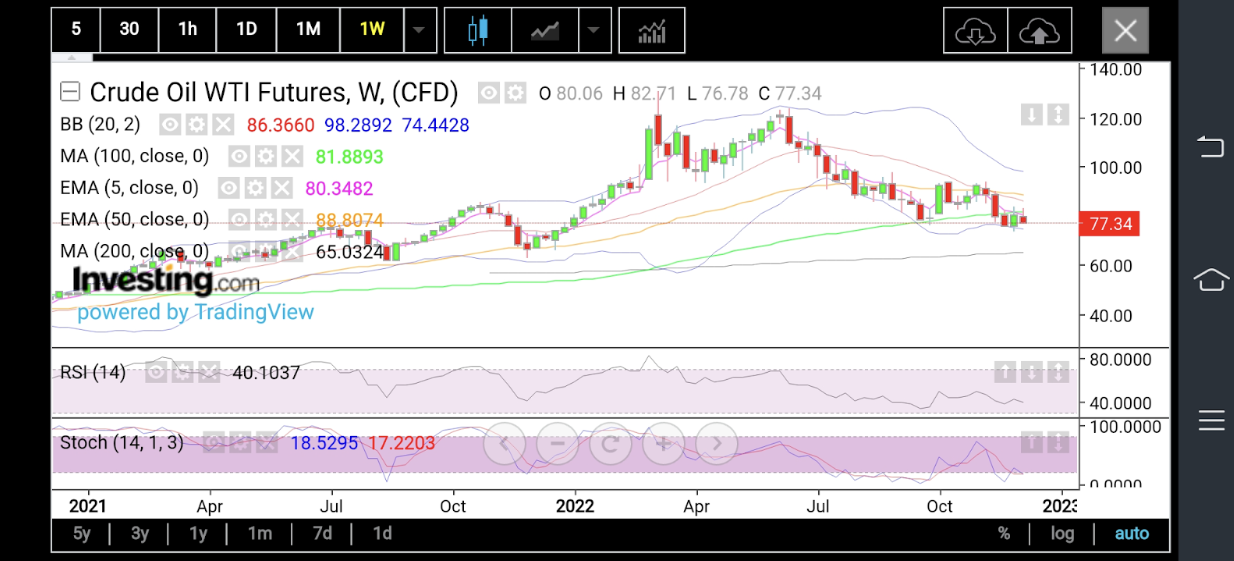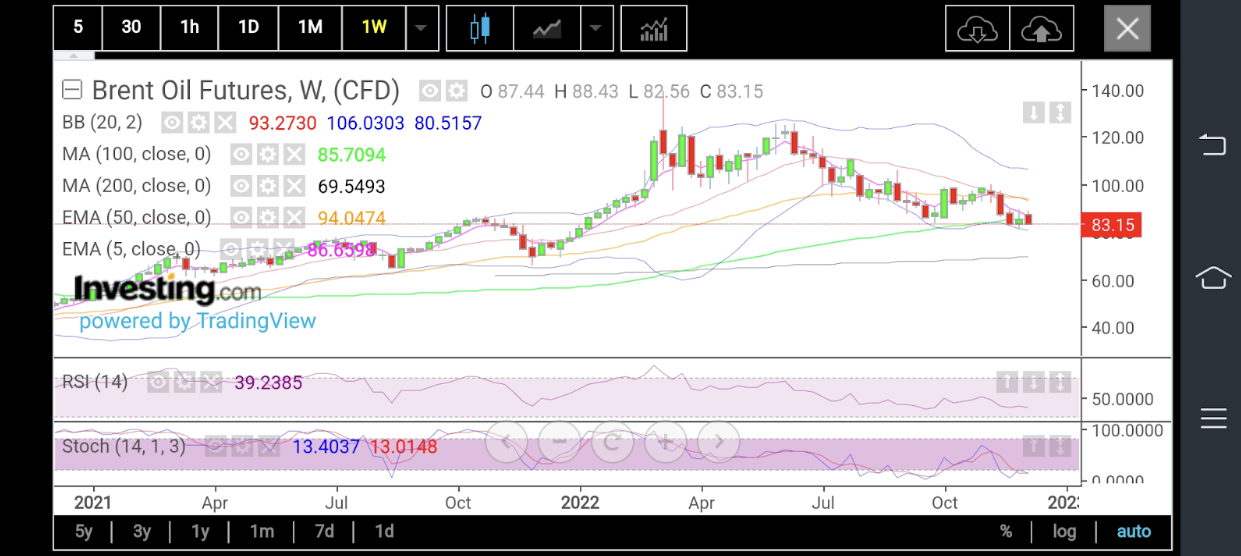- Russia needs to back up its defiance of the oil price cap with proof
- China could do more reopenings from COVID lockdowns
- OPEC+ needs to inject support into the market with hawkish talk; if not, cuts
- WTI bottom seen at $71.30, Brent at $75.50
For a while between Sunday night and Monday morning in New York, it looked like oil bulls had got what they wanted: Russia appeared to be mad—really mad—at the price cap on its oil by the West.
Also, the OPEC+ meeting that ended at the weekend left production plans by the 23 oil producers in the alliance unchanged, presumably in anticipation of a severe Russian crude supply squeeze in Europe as the Kremlin reacts indignantly to the West’s price cap.
Last but not least, several Chinese cities, including economic hubs Shanghai and Beijing, were reported to have loosened the COVID-related restrictions that led to fierce public protests in recent weeks.
The combination of the three sent oil prices up almost 3.5% at one point on Monday, with U.S. West Texas Intermediate crude reaching $82.71 per barrel and London-traded Brent $88.44.
Oil eventually closed the day down 2%, slumping as the dollar rallied for the first time in four sessions after orders for U.S. factory-made goods rose 1% in October. It was the 12th increase in 13 months for factory orders versus manufacturing, which contracted in November for the first time in 2-1/2 years, according to a measure by the Institute for Supply Management (ISM).
Separately, the ISM-tracked services sector showed a reading of 56.5 in November on Monday versus 54.4 in October. Economists had predicted a reading of 53.3 for last month.
The economic data meant one thing: the Fed could turn aggressive with rate hikes again in the new year.
Economist Adam Button said in a post on the ForexLive forum:
“The thinking is that we might not be at the peak of U.S. rates after all. For sure, the Fed is going to pause at some point next year at around 5%, but if the numbers keep running hot like this, they won’t pause for long. The worry is that 5% rates aren’t going to be enough, and the Fed will eventually have to hike to 6-7% (or higher). The issue is that we don’t really know how the U.S. economy will react to those rates then. It’s been so long since the U.S. has had genuinely high rates that it’s a tough call.”
So, what could prop oil back up?
The same three things:
1. Russia Freezes Oil Exports to Defy the Price Cap
It won’t just do for Russia to say the price cap is unacceptable. It has to show proof of its defiance by cutting supplies off the market.
For the record, Kremlin spokesman Dmitry Peskov said Russia “will not accept” the $60-per-barrel cap on its oil and is analyzing how to respond. The cap would destabilize global energy markets but not affect Moscow’s ability to sustain what it calls its “special military operation” in Ukraine, Peskov added.
For context, the price cap by the Group of Seven, or G7, countries will allow non-EU nations to continue importing seaborne Russian crude oil, but it will prohibit the shipping, insurance, and reinsurance companies from handling cargoes of Russian crude around the globe unless it is sold for less than $60. That could complicate the shipment of Russian crude priced above the cap, even to countries that are not part of the agreement. Russian Urals crude traded at around $67 a barrel on Friday.
But the White House, responding to the Kremlin’s ire, suggested that WTI and Brent will ultimately come around to the advantage of consuming countries.
John Kirby, coordinator for strategic communications at the National Security Council in the White House, said:
“We believe that the oil price cap will have no long-term impact on global oil prices. We are confident that this price cap will secure the discount on Russian oil.”
The retreat in crude’s highs on Monday came as some traders were still not entirely sure that the E.U. price cap of $60 per barrel imposed on Russian oil—meant to punish Moscow over its war against Ukraine—would be bullish for oil.
Crude traders had initially feared that E.U. countries might go for a much smaller limit of $50 a barrel or below that could sufficiently anger President Vladimir Putin and prompt him to carry out his threat of slashing Russian oil production or exports to punish Europe instead over the move. But by moving up the cap, Europe may avert any Russian retaliation—keeping Moscow’s oil supplies flowing and crude prices lower.
The Kremlin has reiterated that it will not do business with any country that tries to apply the price cap on Russian oil. But industry experts said it might not be entirely possible for Moscow to escape Western shipping and financial services that were tied to the price cap.
John Kilduff, partner at New York energy hedge fund Again Capital, said:
“It’s obvious that by keeping its production unchanged, OPEC+ is hedging on the theory that there will be a sizable and palpable shortage of oil in the market due to the E.U. ban and price cap on Russian oil. I’m not really sure that’s the case, and until we get the export numbers on Russian oil, I’ll stay cautious on any bullish projections for oil.”
2. More China Reopenings From COVID
China relaxed some movement and testing measures over the past week, drumming up hopes for a nationwide reversal. Reports also suggested that Beijing planned to announce more relief in the coming weeks.
The Xi Jinping administration needs to do more of these to boost real—or, at least, perceived—oil demand in the world’s largest crude-importing nation.
Such reopenings would be largely positive for crude markets. Dwindling demand due to China’s strict anti-COVID policies was a major source of selling pressure on oil markets this year.
The consensus among health experts and veteran China observers is that Beijing will likely loosen some of its strictest health policies and end up increasing COVID caseloads in the process. New infections from the virus hit a record high of 31,444 on Nov. 24. Some fear more dramatic spikes in a population that has a massive immunity gap for COVID compared with other nations—despite China’s relative experience in being the first to fight the global outbreak of the virus three years ago.
And the more the COVID duress on China, the more its contagion impact on oil, say analysts who predict the country could experience a demand slide of more than 1 million barrels per day versus the norm.
“Chinese crude imports may go below 9 million barrels per day in January, Amrita Sen, director of research at Energy Aspects, said in a Nov. 29 interview with Bloomberg Television.
Chinese oil imports stood at a five-month high of 10.2 million barrels per day in October—slightly above the pre-virus average—after the government issued an additional fuel-export quota in an attempt to help revive the country’s economy.
“Our view remains that zero COVID will be in place through the winter,” Sen said, adding that Energy Aspects’ base case was for a China reopening from COVID in April.
Jeff Currie, global head of commodities at Goldman Sachs, told CNBC recently that “demand is probably heading south again in China given what’s going on.”
Ole Hansen, Head of Commodity Strategy at Saxo Bank, also said energy traders had been mostly focused on China’s demand for oil. He said on Tuesday;
“The slowdown in demand from China will be temporary, but having unsuccessfully fought COVID outbreaks with lockdowns for months, the prospect for an improvement looks months away, and with the added risk of an economic slowdown reducing demand elsewhere, traders have increasingly been forced to change their short-term outlook.”
3. OPEC+ Support
OPEC+ — which represents the 13-member Saudi-led Organization of the Petroleum Exporting Countries and ten other oil producers steered by Russia — had announced in October a 2 million-barrels-per-day reduction that is to last through 2023.
At the weekend, the alliance decided to stick to those targets, probably on the presumption that the Russian price cap and China reopenings will help crude prices recover much of the 40% they had lost from March highs.
Where oil bulls are concerned, OPEC+ exists for one purpose and one purpose only: To support oil prices by cutting production whenever necessary.
The alliance doesn’t have to cut again, but it can be more hawkish in talking about wanting higher crude prices — just like the Fed wanting lower rates at some point.
But on another level: Have crude prices bottomed? And if not, how much lower could they go?
Bottom for WTI

Chart by SKCharting, with data powered by Investing.com
We’ll enlist the help of commodities markets chartist Sunil Kumar Dixit of SKCharting.com for this.
According to Dixit, technically, the downside potential for U.S. crude is limited:
“Short-term bottom may have already happened at previous week’s low of $73 or may come somewhere between $72 and $71.
Our observations are mostly based on the fact that prices have not violated the previous week’s low of $73.60. In the event of a sustained break above the previous week’s high of $83.33, we see a further up move to test the weekly Middle Bollinger Band of $86.35, followed by the 50-week EMA of $88.80.”
On the flip side, if the previous week’s low of $73.60 fails to hold as support, prices can drift lower a little more to test immediate support areas of the 200-month Simple Moving Average, or SMA, of $72.60, followed by the 50-month EMA of $71.30.
Bottom for Brent

Chart by SKCharting, with data powered by Investing.com
The weekly price action for Brent remains positive, given the previous week’s low of $80.60 was still intact, said Dixit, adding that:
“As long as this $80.60 low is not violated, a rebound towards the 100-week SMA of $85.44, followed by the 5-week EMA of $88.40, is likely.”
A break above Brent’s previous week’s high of $89.37 may extend the rebound towards the confluence zone of the weekly Middle Bollinger Band of $94.27 and the 50-week EMA of $94.50, Dixit said.
But he also cautioned that the previous month’s potentially bearish engulfing candle formation could keep the rebound under check if the confluence zone of the 5-month EMA of $89.26 and the monthly Middle Bollinger Band of $88.56 continue to act as resistance.
This could result in Brent drifting lower to the 200-month SMA of $77.60, followed by the 50-month EMA of $75.50.
Disclaimer: Barani Krishnan uses a range of views outside his own to bring diversity to his analysis. For neutrality, he sometimes presents contrarian views and market variables. He does not hold positions in the commodities and securities he writes about.
